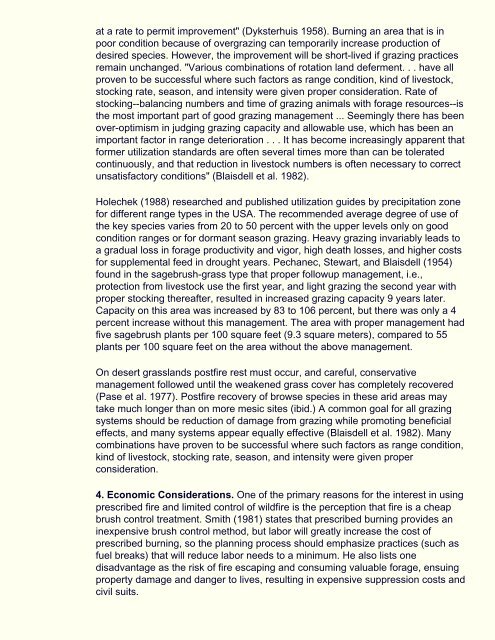FIRE EFFECTS GUIDE - National Wildfire Coordinating Group
FIRE EFFECTS GUIDE - National Wildfire Coordinating Group
FIRE EFFECTS GUIDE - National Wildfire Coordinating Group
You also want an ePaper? Increase the reach of your titles
YUMPU automatically turns print PDFs into web optimized ePapers that Google loves.
at a rate to permit improvement" (Dyksterhuis 1958). Burning an area that is in<br />
poor condition because of overgrazing can temporarily increase production of<br />
desired species. However, the improvement will be short-lived if grazing practices<br />
remain unchanged. "Various combinations of rotation land deferment. . . have all<br />
proven to be successful where such factors as range condition, kind of livestock,<br />
stocking rate, season, and intensity were given proper consideration. Rate of<br />
stocking--balancing numbers and time of grazing animals with forage resources--is<br />
the most important part of good grazing management ... Seemingly there has been<br />
over-optimism in judging grazing capacity and allowable use, which has been an<br />
important factor in range deterioration . . . It has become increasingly apparent that<br />
former utilization standards are often several times more than can be tolerated<br />
continuously, and that reduction in livestock numbers is often necessary to correct<br />
unsatisfactory conditions" (Blaisdell et al. 1982).<br />
Holechek (1988) researched and published utilization guides by precipitation zone<br />
for different range types in the USA. The recommended average degree of use of<br />
the key species varies from 20 to 50 percent with the upper levels only on good<br />
condition ranges or for dormant season grazing. Heavy grazing invariably leads to<br />
a gradual loss in forage productivity and vigor, high death losses, and higher costs<br />
for supplemental feed in drought years. Pechanec, Stewart, and Blaisdell (1954)<br />
found in the sagebrush-grass type that proper followup management, i.e.,<br />
protection from livestock use the first year, and light grazing the second year with<br />
proper stocking thereafter, resulted in increased grazing capacity 9 years later.<br />
Capacity on this area was increased by 83 to 106 percent, but there was only a 4<br />
percent increase without this management. The area with proper management had<br />
five sagebrush plants per 100 square feet (9.3 square meters), compared to 55<br />
plants per 100 square feet on the area without the above management.<br />
On desert grasslands postfire rest must occur, and careful, conservative<br />
management followed until the weakened grass cover has completely recovered<br />
(Pase et al. 1977). Postfire recovery of browse species in these arid areas may<br />
take much longer than on more mesic sites (ibid.) A common goal for all grazing<br />
systems should be reduction of damage from grazing while promoting beneficial<br />
effects, and many systems appear equally effective (Blaisdell et al. 1982). Many<br />
combinations have proven to be successful where such factors as range condition,<br />
kind of livestock, stocking rate, season, and intensity were given proper<br />
consideration.<br />
4. Economic Considerations. One of the primary reasons for the interest in using<br />
prescribed fire and limited control of wildfire is the perception that fire is a cheap<br />
brush control treatment. Smith (1981) states that prescribed burning provides an<br />
inexpensive brush control method, but labor will greatly increase the cost of<br />
prescribed burning, so the planning process should emphasize practices (such as<br />
fuel breaks) that will reduce labor needs to a minimum. He also lists one<br />
disadvantage as the risk of fire escaping and consuming valuable forage, ensuing<br />
property damage and danger to lives, resulting in expensive suppression costs and<br />
civil suits.
















